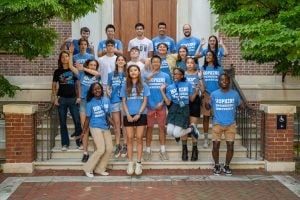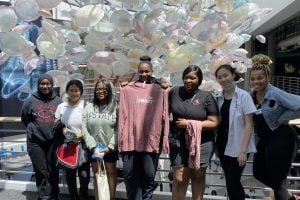
This article originally appeared on The Hub.
More than 150 high school students from across the country and from locations around the world gathered at Johns Hopkins University’s Homewood campus on Friday to test their bridge structures, made entirely out of spaghetti and epoxy.
The event is the final challenge of the four-week Engineering Innovation program, an immersive, pre-college summer experience offered through JHU’s Whiting School of Engineering.
“From an academic standpoint, this event marks the culmination of your Engineering Innovations studies, and that alone makes it worth celebrating,” said Ed Schlesinger, dean of the Whiting School, during his opening remarks. “This is no small feat. … The world needs creative, talented, innovative problem-solvers.”
More than 40 teams competed under names featuring spectacular pasta puns, including “The Spaghettysburg Address,” “The Ramen Emperors,” and “Spaghett About It.”
Their construction strategies often followed a similar theme.
“We decided to do a bridge that had an arch,” said Jasmin Thames, who will be a senior at Baltimore Polytechnic Institute in the fall. She competed with team Spaghetti Yetis. “Arches were a common theme, but there were different configurations in the middle of the bridge to set them apart.”
Some teams opted for heft, building bridges that were heavily reinforced—despite the penalty they would face for having an overweight bridge. Others opted for a strategy of placing the weights—which dangled below each structure from an eye hook screwed into the center—as nimbly as possible.
“The thing about spaghetti is that it can’t hold shock, so you have to place the weights very carefully because it might break with, say, five kilograms of shock, and we try to maximize the weight it can hold by placing it slowly, slowly,” said Giovanni Ferioli, a rising senior from Miami, Florida, who competed on team Pasta la Vista A. “We tested our bridge before, we had three rough drafts, and we realized that between the first and the second that we can’t just place the weight, because it breaks from shock before it breaks from the weight it can hold.”
Others knew they were doomed from the start.
“Our bridge broke under the weight of the chain,” said Will Zhu, a rising junior from Los Angeles, California, who competed on team The Impastables. “I think the epoxy was denatured on one of the joists, because it didn’t adhere to itself even after we cured it for three days. We saw it was breaking when we tested it this morning. But personally, my goal for this project was to make something that looked cool, and we did that, so it’s a success.”
“We had that problem, too, where the epoxy wasn’t completely dry,” added Omar Geier, a rising senior from Dubai whose team name was Endless Pastabilities. “Our main problem is that we focused too much on the trusses and not the actual loading platform. That’s what broke for us, because we didn’t spend enough time on it.”
The teams that fared the best in the Homewood competition were:
- First place: Bridge Guys, which included team members Diego San Miguel, Simon Alloca, and Ian Shibley-Styer
- Second place: The Ramen Emperors, which included team members Connor Cremers, Joanna Elia, Jessica Wiederhorn, and Claire Zhu
- Third place: Yeah Science!, which included team members Sergio Arenas, Ayelet Gross, Dina Leyzarovich, and Jack Mehr
Engineering Innovations program cohorts in California; Ohio; Pennsylvania; Washington, D.C.; and elsewhere in Maryland—including at the Johns Hopkins Applied Physics Laboratory and JHU’s Montgomery County campus—also took part. Participants came from 20 states and U.S. territories and 17 countries.
Ask any of the students who participated, and they’ll say the Spaghetti Bridge competition wasn’t their main focus during Engineering Innovations. The main draw, the consensus seemed to be, was the chance to work on their science and math skills, learn from the outstanding faculty at the Whiting School of Engineering, and to meet peers interested in STEM.
“We bonded on the first day,” said David Mitchell, who came to the EI program from the Netherlands and worked with Geier on team Endless Pastabilities. “We have like-minded people who have really intelligent conversations. … It was really easy to work with each other.”


